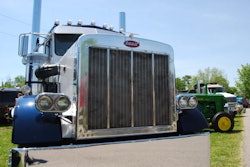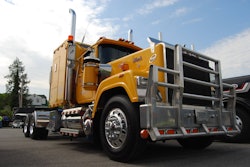If you’ve not taken the opportunity to tell the Federal Motor Carrier Safety Administration your thoughts on just how electronic onboard recorders for hours-of-service monitoring are or will be used in the industry, today is your day. For haulers shutting down in late afternoon on the East Coast, the opportunity is particularly good.
The agency’s listening session on EOBRs and harrassment is taking place live on the West Coast in conjunction with a meeting of law enforcement representatives in Bellevue, Wash. You’ll need to register (a very quick procedure) to view the webcast online via FMCSA’s main page. Once registered and logged in, there’s a very intuitive, simple tool for submitting commentary.
The Owner-Operator Independent Drivers Association yesterday released a letter delivered to members of Congress regarding the measure in the Senate’s MAP-21 two-year highway bill proposal that would mandate EOBRs industrywide. That bill is set to go to conference with the House’s bill to extend current funding levels quite soon. Find the partial text of that letter below, but first consider E.F. McHenry’s commentary on news of the listening session published yesterday here at OverdriveOnline:com, which distills many owner-operators’ thoughts on EOBRs’ potential use as harassment tools quite well, I thought:
“EOBRs will do many things to the detriment of the driver,” McHenry wrote. “EOBRs create a sense that only driving counts as work and that tracking truck movement accurately is equivalent to compliance. We know that is completely wrong! EOBRs also turn the hours of service rule on its head in the sense that EOBRs have been and will be used by large trucking companies in profound ways to treat HOS rules not as limits to work but as mandates to work.”
I don’t know if this kind of analysis of the systemic effects an EOBR mandate could have on the business of owning and driving a truck will impress the regulators viz a viz the harassment issue. But all the same, it’s spot-on with the primary concern that many have voiced to me over the years regarding EOBRs.
If you’re currently running with one and have experienced the dynamic McHenry describes, or if you have another point of view (and I’ve mostly certainly heard those as well), tune in today and tell the regulators.
TEXT FROM THE OOIDA LETTER:
One of the many contrasts between the Senate and the House approach to reauthorization is in the area of motor carrier safety, specifically language in the Senate’s bill that would mandate Electronic On-Board Recorders (EOBRs) for compliance with hours-of-service regulations. OOIDA strongly opposes such a mandate on a number of grounds, especially the fact that this is a costly burden on the small business trucker and the trucking industry with no proven safety benefit. We respectfully ask that the conferees consider removing such language from any final bill.
As you remember, last August Speaker Boehner wrote the President requesting a list of the most expensive regulations being developed by the Administration. The $2 billion EOBR mandate came back as not only one of the seven most costly rules, but also the most expensive regulatory proposal within the Department of Transportation – costing nearly two times the recently finalized changes to hours-of-service regulations.
Section 32301 of S. 1813 legislatively mandates this burdensome regulatory effort under the guise of monitoring hours of service compliance despite the fact that the costly hours of service change is still being heavily disputed. To require such a mandate before the rule is even settled is putting the cart way before the horse to say the least, particularly absent any research to indicate that EOBRs will improve upon compliance as a whole.
Currently, truckers utilize paper logbooks that are available at truck stops or from carriers for little or no charge. The on-board recorders as mandated under the Senate bill are estimated to cost between $1,000 and $1,500 to purchase. Further, the language in S. 1813 will require these devices have a real-time tracking capability – a requirement that has no clear connection to HOS compliance but one that will require motor carriers, including small business and owner-operator truckers, to pay monthly service charges estimated at $50 or more per month per device.
For an owner-operator, the cost of an EOBR over ten years will run at least $7,500 (not including maintenance and training charges) – despite the fact that there is no clear scientific proof that these devices will improve highway safety. In addition, such tracking devices raise serious concerns about privacy and invoke “big brother” imagery for drivers as OOIDA has long held that EOBRs are widely used in the industry to simply harass drivers and attempt to stimulate “productivity” regardless of the ramifications to a driver’s ability to obtain meaningful rest and otherwise be in compliance with the law. Recently, OOIDA won a victory in court which required the Department of Transportation to vacate the current rule because it could not show how these devices could not be utilized to harass drivers. Regardless, the agency presses on and will do so even faster should this mandate be included in a final surface transportation bill.









